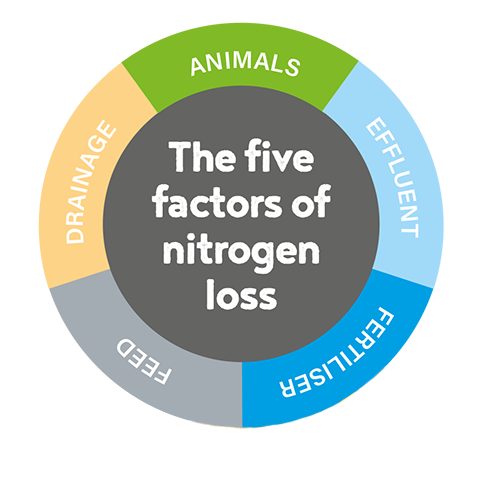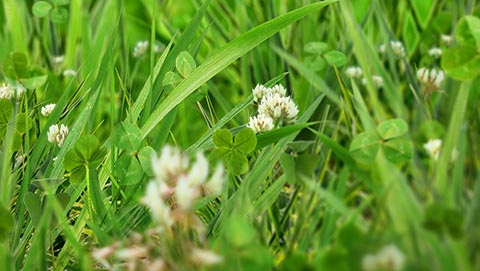All farm systems will lose nitrogen to some degree. Nitrogen can be lost to the air as a gas or it can leach out in soil water drainage.
Losses to water occur because soil bacteria convert urea to nitrate, which is a form of nitrogen that mainly stays in the soil water. As a result, when it rains and soil water moves down through the soil, below the root zone, any excess nitrate moves too. This is the process known as nitrate leaching. Losses to the air mainly occur as a result of volatilisation, which happens when urea is converted to ammonia gas through the activity of enzymes that are found in soil and on plants.
Nitrate leaching is the major mechanism for nitrogen loss on most farms. This may constitute an economic loss for the farm, as it means the nitrogen is not being used for plant growth. Nitrate leaching is also the loss pathway that has the greatest potential for environmental impact on nearby waterways.
There are five main factors that together govern how much nitrogen will be lost by leaching on any given farm. These are: animals, effluent, fertiliser, feed and drainage.
Animal factors
Animal urine is the single greatest source of nitrogen leaching in a pastoral system. A typical dairy cow urination deposits 2 litres of urine on just 0.2 m2 of land. It’s highly concentrated, which increases the chance of leaching. The more protein in the feed, the more nitrogen in the urine.
At higher stocking rates, urine patches overlap, causing even greater concentrations of nitrogen. On the other hand, lighter breeds of cow deposit less urine nitrogen, but this is only of benefit if stocking rates are not increased to compensate for lower production.
The following changes to stock management may be considered:
- Reducing stocking rate - this will immediately reduce nitrogen inputs, but the effect on rotations, production and profitability needs to be considered
- Using lower protein feeds - reducing protein intake will reduce the nitrogen loading in the urine. The overall diet of the animal needs to be considered when this option is being investigated Adopting low-impact winter grazing practices - most nitrate leaching occurs during late autumn and winter, so wintering off, time-limited grazing, using a feed pad, wintering pad or an animal shelter (with good effluent management practices) through winter can reduce losses
Effluent factors
The amount of nitrogen in effluent varies with season and feed type. The degree of impact that effluent has on nitrate leaching depends largely on the way effluent is used. Nitrate leaching is increased by heavy applications and by applying effluent to wet soils.
Consider the following strategies to reduce this impact:
- Increasing the effluent area - this reduces the average amount of nutrients spread per hectare
- Using low application rates - this increases the likelihood that plants will use the water and nutrients, rather than this material being lost to waterways
- Exporting effluent - in some cases it may be possible to get someone else to use farm effluent, e.g. on a paddock that is going to be used for maize
Fertiliser factors
Nitrogen fertiliser only has a small direct impact on nitrate leaching, but it is a relatively easy factor to control. The following points should be considered:
- Use good agricultural practice - follow the fertiliser industry’s guidelines for nitrogen application in order to minimise the risk of nitrate leaching and maximise the value from nitrogen fertiliser
- Time nitrogen applications appropriately - apply nitrogen fertiliser when pasture is growing, so that plants can use it. If soils are too wet or cold, uptake will be low and the risk of loss higher
- Use a little-and-often approach - applying frequent small applications of nitrogen allows less nitrogen to be used without any loss of pasture yield
- Increase pasture utilisation - minimising wastage reduces the need for nitrogen fertiliser to grow more grass to meet feed demand
Feed factors
Feed is an easily overlooked source of nitrogen that can contribute to nitrate leaching. Fodder crops and imported supplement both affect the amount of nitrate leaching from a farm, with high-protein feeds having more of an impact than low-protein feeds. Grazing practices also influence nitrate leaching: strip grazing concentrates urine in a small area, increasing the risk for nitrate leaching.
- Use lower protein feeds - this helps to reduce the nitrogen load in the urine and hence in the soil. The overall diet of the animal also needs to be kept in mind when considering feed options
Drainage factors
Nitrogen is leached from soil when water moves below plant roots. How much water can be held before drainage occurs is determined largely by soil type. Stony soils, sands, gravels and pumice soils drain easily, so they are more prone to nitrate leaching. Areas that get more rainfall also experience more drainage, regardless of the soil type.
Soil type and rainfall are beyond the control of farmers, but irrigation can be managed to minimise the risk of nitrate leaching.
- Refine irrigation timing - monitor soil moisture levels to ensure that irrigation does not exceed the moisture-holding capacity of the soil.
Monitoring progress
The impact of making changes to manage nitrate leaching cannot be assessed unless there is an effective monitoring programme in place. A nutrient budget, calculated using OverseerFM®, is an effective way to do this, as it automatically estimates nitrate leaching loss and calculates nitrogen efficiency values. However, for these numbers to be meaningful, the data that is used to develop the nutrient budget must be accurate.
Download and read the full fact sheet


Understanding Nitrogen on your farm
Nitrogen plays an important role in New Zealand agriculture. When used appropriately, it is an effective addition to the nitrogen provided naturally by clovers and other legumes.
To help you understand nitrogen use on your farm we have collated a range of nitrogen advice backed by science.